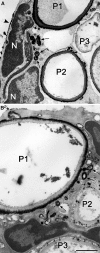Reactive oxygen species in phagocytic leukocytes
- PMID: 18597105
- PMCID: PMC2491708
- DOI: 10.1007/s00418-008-0461-4
Reactive oxygen species in phagocytic leukocytes
Abstract
Phagocytic leukocytes consume oxygen and generate reactive oxygen species in response to appropriate stimuli. The phagocyte NADPH oxidase, a multiprotein complex, existing in the dissociated state in resting cells becomes assembled into the functional oxidase complex upon stimulation and then generates superoxide anions. Biochemical aspects of the NADPH oxidase are briefly discussed in this review; however, the major focus relates to the contributions of various modes of microscopy to our understanding of the NADPH oxidase and the cell biology of phagocytic leukocytes.
Figures







Similar articles
-
Phagocytic leukocytes and reactive oxygen species.Histochem Cell Biol. 2009 Apr;131(4):465-9. doi: 10.1007/s00418-009-0565-5. Epub 2009 Feb 18. Histochem Cell Biol. 2009. PMID: 19224236 Review.
-
Measurement of Respiratory Burst Products, Released or Retained, During Activation of Professional Phagocytes.Methods Mol Biol. 2020;2087:301-324. doi: 10.1007/978-1-0716-0154-9_22. Methods Mol Biol. 2020. PMID: 31729000
-
Cell-Free NADPH Oxidase Activation Assays: A Triumph of Reductionism.Methods Mol Biol. 2020;2087:325-411. doi: 10.1007/978-1-0716-0154-9_23. Methods Mol Biol. 2020. PMID: 31729001 Review.
-
NADPH oxidase-mediated generation of reactive oxygen species is critically required for survival of undifferentiated human promyelocytic leukemia cell line HL-60.Free Radic Res. 2004 Jun;38(6):629-37. doi: 10.1080/10715760410001694053. Free Radic Res. 2004. PMID: 15346654
-
Chronic Granulomatous Disease.Methods Mol Biol. 2019;1982:531-542. doi: 10.1007/978-1-4939-9424-3_32. Methods Mol Biol. 2019. PMID: 31172494 Review.
Cited by
-
Effect of Byrsonima crassa and phenolic constituents on Helicobacter pylori-induced neutrophils oxidative burst.Int J Mol Sci. 2012;13(1):133-41. doi: 10.3390/ijms13010133. Epub 2011 Dec 23. Int J Mol Sci. 2012. PMID: 22312243 Free PMC article.
-
Oxidative stress induces inflammation of lens cells and triggers immune surveillance of ocular tissues.Chem Biol Interact. 2022 Mar 1;355:109804. doi: 10.1016/j.cbi.2022.109804. Epub 2022 Feb 4. Chem Biol Interact. 2022. PMID: 35123994 Free PMC article.
-
Genotoxic Potential of Nanoparticles: Structural and Functional Modifications in DNA.Front Genet. 2021 Sep 29;12:728250. doi: 10.3389/fgene.2021.728250. eCollection 2021. Front Genet. 2021. PMID: 34659351 Free PMC article. Review.
-
Neutrophils: Beneficial and Harmful Cells in Septic Arthritis.Int J Mol Sci. 2018 Feb 5;19(2):468. doi: 10.3390/ijms19020468. Int J Mol Sci. 2018. PMID: 29401737 Free PMC article. Review.
-
State-of-the-art technologies, current opinions and developments, and novel findings: news from the field of histochemistry and cell biology.Histochem Cell Biol. 2008 Dec;130(6):1205-51. doi: 10.1007/s00418-008-0535-3. Epub 2008 Nov 5. Histochem Cell Biol. 2008. PMID: 18985372 Review.
References
-
- {'text': '', 'ref_index': 1, 'ids': [{'type': 'PMC', 'value': 'PMC1137899', 'is_inner': False, 'url': 'https://pmc.ncbi.nlm.nih.gov/articles/PMC1137899/'}, {'type': 'PubMed', 'value': '8141770', 'is_inner': True, 'url': 'https://pubmed.ncbi.nlm.nih.gov/8141770/'}]}
- Abo A, Webb MR, Grogan A, Segal AW (1994) Activation of NADPH oxidase involves the dissociation of p21rac from its inhibitory GDP/GTP exchange protein (rhoGDI) followed by its translocation to the plasma membrane. Biochem J 298:585–591 - PMC - PubMed
-
- {'text': '', 'ref_index': 1, 'ids': [{'type': 'PubMed', 'value': '10233905', 'is_inner': True, 'url': 'https://pubmed.ncbi.nlm.nih.gov/10233905/'}]}
- Allen L-AH, DeLeo FR, Gallois A, Toyoshima S, Suzuki K, Nauseef WM (1999) Transient association of the nicotinamide adenine dinucleotide phosphate oxidase subunits p47phox and p67phox with phagosomes in neutrophils from patients with X-linked chronic granulomatous disease. Blood 93:3521–3530 - PubMed
-
- {'text': '', 'ref_index': 1, 'ids': [{'type': 'PubMed', 'value': '1259763', 'is_inner': True, 'url': 'https://pubmed.ncbi.nlm.nih.gov/1259763/'}]}
- Allen RC, Loose LD (1976) Phagocytic activation of a luminol-dependent chemiluminescence in rabbit alveolar and peritoneal macrophages. Biochem Biophys Res Commun 69:245–252 - PubMed
-
- {'text': '', 'ref_index': 1, 'ids': [{'type': 'PubMed', 'value': '5026288', 'is_inner': True, 'url': 'https://pubmed.ncbi.nlm.nih.gov/5026288/'}]}
- Allen RC, Stjernholm RL, Steele RH (1972) Evidence for the generation of an electronic excitation state(s) in human polymorphonuclear leukocytes and its participation in bactericidal activity. Biochem Biophys Res Commun 47:679–684 - PubMed
-
- {'text': '', 'ref_index': 1, 'ids': [{'type': 'PubMed', 'value': '15059619', 'is_inner': True, 'url': 'https://pubmed.ncbi.nlm.nih.gov/15059619/'}]}
- Ambruso DR, Cusack N, Thurman G (2004) NADPH oxidase activity of neutrophil specific granules: requirements for cytodolic components and evidence of assembly during cell activation. Mol Genet Metab 81:313–321 - PubMed
Publication types
MeSH terms
Substances
LinkOut - more resources
Full Text Sources

